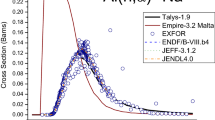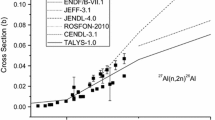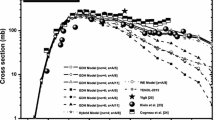Abstract
Structural material selection in design of fusion reactors is very crucial. These structural materials should satisfy the hard conditions such as high thermo-mechanical stresses, high heat loads and severe radiation damage without compromising on safety considerations. The materials such as titanium, vanadium and chromium are used in the construction of fusion reactors. Therefore, it is important to examine these materials. Obtained results from the nuclear reactions using structural materials can be used for developing of these structural materials. For this reason, in this study cross sections of the 46Ti(α,n) 49Cr, 50Cr(α,n) 53Fe and 51V(α,n) 54Mn reactions have been calculated at 2–20 MeV energy range. In these theoretical calculations, the TALYS 1.8 and NON-SMOKER codes were used. Also, the astrophysical S-factors which describe the possibility of reaction in low energies were calculated. Results of our calculations were checked to the experimental data obtained from EXFOR database.
Similar content being viewed by others
Avoid common mistakes on your manuscript.
Introduction
The selection of structural material is very important in construction of fusion reactors. These structural materials should satisfy the several important properties. These properties are high thermo-mechanical stresses, high heat loads and the resistance to radiation damage. The progress of component structural materials is a great step towards fusion reactors becoming an efficient source of energy, especially if the hope of an environmentally safe machine is to be maintained [1]. Raole and his colleagues said that “Fundamental knowledge of behavior of the material indifferent environments and particularly after irradiation, is essential for improving properties and therefore, large data base with modeling can be used for the development of advanced structural materials” [2].
Titanium, vanadium and chromium alloys are used in the construction of fusion reactors. Vanadium alloys have high-performance mechanical and physical properties, good fabricability, high neutron fluence support capability, accommodation ability of high heat loads, low degradation under neutron irradiation, low decay heat, low waste disposal rating and potential for high performance and long operating lifetime in a fusion environment [3]. Titanium alloys have many important features. These properties make them attractive structural materials for fusion reactors. For example, the high electrical resistivity, small modulus of elasticity, the heat capacity and the high corrosion are some of the properties of titanium [1]. Chromium alloys as potential structural material in fusion reactors arise from their perfect low activation features and their potential high service temperature of up to 1000 K [4].
Therefore, it is important to examine above materials. Obtained results from the nuclear reactions using structural materials can be used developing for these structural materials. For this reason, in the previous studies we calculated the cross sections and astrophysical S-factors of the (α,n) and (α,γ) reactions for some structural materials, such as Mo, Cu, Ni [5,6,7]. In this study, we have calculated the cross sections of the 46Ti(α,n) 49Cr, 50Cr(α,n) 53Fe and 51V(α,n) 54Mn reactions at 2–20 MeV energy range. In these calculations, the TALYS 1.8 [8] and NON-SMOKER [9] codes were used. Also, the astrophysical S-factors which describe the possibility of reaction in low energies were calculated. We compared our calculations with the experimental data obtained from EXFOR [10] database.
Materials and Methods
Astrophysical S-factor defined as
where, η is the Sommerfeld parameter, (Z1Z2e2)/ħν. S(E) is function of energy with slow variation than exp(−2πη) and cross-sections σ(E). The astrophysical S-factors describe the possibility of reaction in low energies. In astrophysical applications, S(E) should be known for many reactions at low energies, E ≤ a few MeV. Experimental measurements of σ(E) at lower energy are mainly not available (because of the Coulomb barrier exponentially suppresses low-energy cross sections).
Theoretical evaluation of S(E) is model dependent, so that nuclear physics uncertainties of evaluated S-factor can be substantial [11].
In this study, firstly, we calculated the reaction cross-sections of the 46Ti(α,n) 49Cr, 50Cr(α,n) 53Fe and 51V(α,n) 54Mn reactions by TALYS 1.8 [8] and NON-SMOKER [9] codes up to 20 MeV. Then the astrophysical S-factors were calculated using Eq. (1).
Calculations and Results
The (α,n) reaction cross sections of given reactions were calculated in the incident energy range of 2–20 MeV by using default values in the TALYS 1.8 [8] and NON-SMOKER [9] codes. Obtained results were compared to the available experimental data of EXFOR [10] database in Figs. 1, 2 and 3. We can see that the calculated data by TALYS are agreement with all the experimental data [12, 14,15,16,17,18,19,20,21,22] except Howard’s data [13] for 46Ti(α,n) 49Cr reaction.
Conclusion
Since the determination of fusion cross section at very low energy becomes a critical issue with the lacking of data from the experimental measurements, theoretical calculation of the astrophysical S-factor can be substantial. It is necessary to calculate astrophysical S-factor for the reactions of interest by a reliable theoretical method in the important energy range and approximate the data by analytical expressions. New measurements extending to energies especially below 8 MeV are needed for these reactions for a better theoretical improvement.
The interactions of the alloys used with Ti, Va and Cr elements with radiation should be investigated. Improvement of these materials for fusion reactors is one of the most crucial area because the success of the future fusion reactor will be largely dependent on the selection.
The results obtained from the nuclear reactions in which structural materials are used can be used to develop these structural materials. These and similar studies will contribute to the selection criteria of these materials.
References
M. Victoria et al., Nucl. Fusion. 41, 1047–1053 (2001)
P.M. Raole et al., Trans. Indian Inst. Met. 62, 105–111 (2009)
M. Ubeyli et al., Mater. Des. 28, 1257–1262 (2007)
U. Holzwarth, H. Stamm, J. Nucl. Mater. 279, 31–45 (2000)
E. Yildiz et al., EPJ Web Conf. 100, 01010 (2015)
E. Yildiz, A. Aydin, J. Fusion Energ. 35, 605 (2016)
A. Aydin, E. Yildiz, I.H. Sarpun, EPJ Web Conf. 128, 01004 (2016)
A.J. Koning, H. Hilaire, S. Goriely, TALYS-1.8 (NRG, Netherland 2017), http://www.talys.eu
D.G. Yakovlev et al., Phys. Rev. C 82, 044609 (2010)
V.N. Levkovskij, Activation Cross Section by Protons and Alphas (Moscow, 1991)
A.J. Howard et al., Astrophys. J. 188, 131–140 (1974)
A.E. Vlieks et al., Nucl. Phys. Sect. A 224, 492–502 (1974)
A.J. Morton et al., Nucl. Phys. Sect. A 573, 276–290 (1994)
A.A. Sonzogni et al., J. Radioanal. Nucl. Chem. 170, 143–156 (1993)
V.Y. Hansper et al., Nucl. Phys. Sect. A 551, 158–172 (1993)
H. Vonach et al., Phys. Rev. Part C Nucl. Phys. 28, 2278–2285 (1983)
A. Iguchi et al., J. Atomic Energy Soc. Jpn. 2, 682–684 (1960)
W.W. Bowman, M. Blann, Nucl. Phys. Sect. A 131, 513–531 (1969)
X. Peng et al., Nucl. Instrum. Methods Phys. Res. Sect. B 152, 432–436 (1999)
D.P. Chowdhury et al., Nucl. Instrum. Methods Phys. Res. Sect. B 103, 261–266 (1995)
Author information
Authors and Affiliations
Corresponding author
Rights and permissions
About this article
Cite this article
Yildiz, E., Aydin, A., Sarpun, I.H. et al. Calculations of Cross-Sections and Astrophysical S-factors for the (α,n) Reactions of Some Structural Fusion Materials. J Fusion Energ 36, 149–151 (2017). https://doi.org/10.1007/s10894-017-0134-1
Published:
Issue Date:
DOI: https://doi.org/10.1007/s10894-017-0134-1







